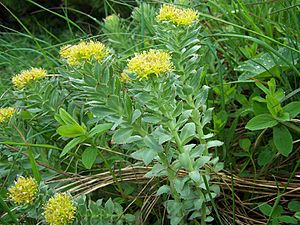Rhodiola rosea facts for kids
Quick facts for kids Rhodiola rosea |
|
|---|---|
 |
|
| Scientific classification | |
| Genus: |
Rhodiola
|
| Species: |
rosea
|
| Synonyms | |
Rhodiola rosea is a cool plant often called golden root or rose root. It's a perennial flowering plant, meaning it lives for more than two years. This plant is part of the Crassulaceae family, which includes many succulents.
You can find Rhodiola rosea growing naturally in cold, wild places. It lives in the Arctic regions of Europe, Asia, and North America. People have used this plant in traditional medicine for a long time for different purposes.
Sadly, Rhodiola rosea's future is at risk in many places. This is because lots of people want it, and it's often collected from the wild. This high demand can harm the environment where it grows.
Contents
Description
Rhodiola rosea plants are usually about 5 to 40 centimeters (2 to 16 inches) tall. They have thick, fleshy stems that grow from a short, scaly root. The flowers are yellow or greenish-yellow, sometimes with red tips. They are small, about 1 to 3.5 millimeters long, and bloom in the summer.
Several shoots can grow from the same thick root. These shoots can reach up to 5 to 35 centimeters (2 to 14 inches) in height. Rhodiola rosea is a dioecious plant. This means that some plants have only male flowers, and other plants have only female flowers.
Taxonomy
The plant Rhodiola rosea was first written about by a person named Pedanius Dioscorides. He included it in his famous book, De Materia Medica. This book was a very old text about medicines.
Some plants in North America that were once thought to be R. rosea are now seen as different species. These include Rhodiola integrifolia and Rhodiola rhodantha.
Chemicals in the Plant
Scientists have found about 140 different chemical compounds in the roots of Rhodiola rosea. Some of these chemicals include phenols, rosavin, rosin, and salidroside. There are also organic acids, terpenoids, and flavonoids.
The exact mix of chemicals can be different depending on where the plant grows. For example, Rhodiola from Russia might have more rosavin. Plants from Bulgaria might have more geraniol. This shows how plants can change based on their environment.
Scientists are still studying these chemicals. They want to understand how these compounds work. Rhodiola rosea also contains other helpful compounds called polyphenols. These polyphenols have been shown to have antioxidant effects in lab tests.
Where it Grows
Rhodiola rosea likes to grow in cold parts of the world. You can find it in many areas of the Arctic. It also grows in the mountains of Central Asia. In North America, it's found in scattered areas, and in mountainous parts of Europe. This plant often grows on sea cliffs or high up in mountains.
Uses
Food
The leaves and young shoots of Rhodiola rosea can be eaten. Some people eat them raw, but they can taste a bit bitter. Others cook them, similar to how you would cook spinach. Sometimes, they are even added to salads. An extract from the plant is also sometimes used to flavor vodkas.
Images for kids
See also
 In Spanish: Rhodiola rosea para niños
In Spanish: Rhodiola rosea para niños





